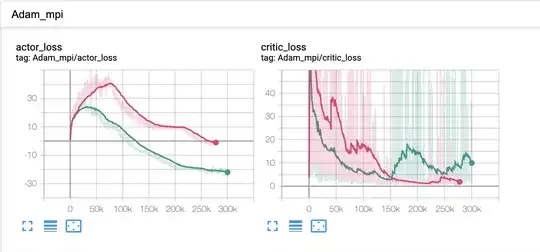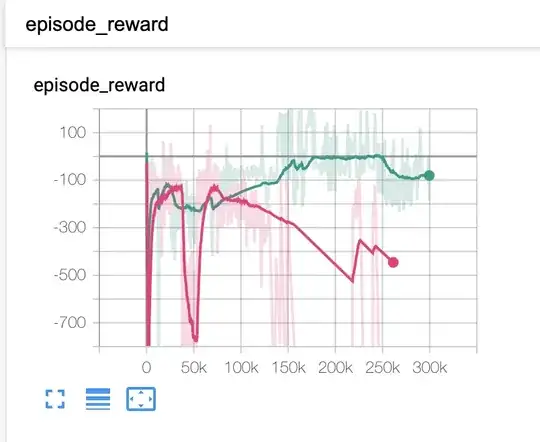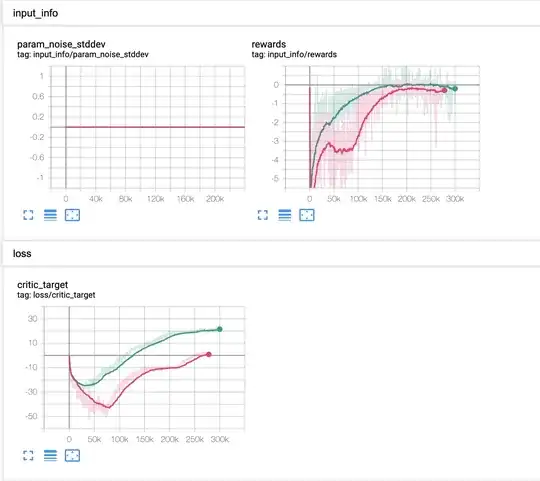I have noticed that DDPG does rather well at solving environments with a static target.
For example, the default of Lunar Lander, the flags do not change position. So the DDPG model learns how to get to the center of the screen and land fairly quickly.
As soon as I start moving the landing position around randomly and adding the landing position as an input to the model, the model has an extremely hard time putting this connection together.
A few questions/points about adding this complexity to the environment:
- Would more nodes per layer or more layers help in figuring out this connection? I have tested this but seems the bigger I go, the harder it is to learn anything.
- Is it a common RL AI issue that it has a hard time connecting data?
- I realize that I could change the environment to always have a static target and instead change the position of the lunar lander ship, which in effect accomplishes the same thing, but want to know if we could solve it with moving target
- Is there any good documentation on Actor/Critic analyzing models? I have some results where my critic target is falling out but my critic loss is going down nicely. At the same time my actor target is going up and up and eventually plateau. It is hard to really understand what is happening and would be great to understand actor loss vs critic loss vs critic target.
Essentially, I added a random int (left side of flags), added 1 to get x position middle of landing and add 1 more to get distance of flags to be 3 out of 11 chunks.
rand_chunk = random.randint(0, CHUNKS-3)
self.x_pos_middle_landing = chunk_x[rand_chunk + 1]
self.helipad_x1 = chunk_x[rand_chunk]
self.helipad_x2 = chunk_x[rand_chunk + 2]
height[rand_chunk] = self.helipad_y
height[rand_chunk + 1] = self.helipad_y
height[rand_chunk + 2] = self.helipad_y
Old State:
state = [
(pos.x - VIEWPORT_W/SCALE/2) / (VIEWPORT_W/SCALE/2),
(pos.y - (self.helipad_y+LEG_DOWN/SCALE)) / (VIEWPORT_H/SCALE/2),
vel.x*(VIEWPORT_W/SCALE/2)/FPS,
vel.y*(VIEWPORT_H/SCALE/2)/FPS,
self.lander.angle,
20.0*self.lander.angularVelocity/FPS,
1.0 if self.legs[0].ground_contact else 0.0,
1.0 if self.legs[1].ground_contact else 0.0
]
Added to State, same as state[0] but using middle of 3 for landing
(self.x_pos_middle_landing - VIEWPORT_W/SCALE/2) / (VIEWPORT_W/SCALE/2)
And update the obs space from 8 spaces to 9
self.observation_space = spaces.Box(-np.inf, np.inf, shape=(9,), dtype=np.float32)
Rewards need to be updated, Old Rewards:
shaping = \
- 100*np.sqrt(state[0]*state[0] + state[1]*state[1]) \
- 100*np.sqrt(state[2]*state[2] + state[3]*state[3]) \
- 100*abs(state[4]) + 10*state[6] + 10*state[7] # And ten points for legs contact, the idea is if you
New Rewards:
shaping = \
- 100*np.sqrt((state[0]-state[8])*(state[0]-state[8]) + state[1]*state[1]) \
- 100*np.sqrt(state[2]*state[2] + state[3]*state[3]) \
- 100*abs(state[4]) + 10*state[6] + 10*state[7] # And ten points for legs contact, the idea is if you
DDPG Model
import tensorflow as tf
import matplotlib.pyplot as plt
import numpy as np
import gym
from tensorflow.keras.models import load_model
import os
import envs
import time
import scipy.stats as stats
# from stable_baselines.common.policies import MlpPolicy, MlpLstmPolicy
from stable_baselines.common.vec_env import SubprocVecEnv, DummyVecEnv, VecCheckNan
from stable_baselines.common import set_global_seeds, make_vec_env
from stable_baselines.ddpg import DDPG
from stable_baselines.ddpg.policies import MlpPolicy
# from stable_baselines.sac.policies import MlpPolicy
from stable_baselines import PPO2, SAC
from stable_baselines.common.noise import NormalActionNoise, OrnsteinUhlenbeckActionNoise, AdaptiveParamNoiseSpec
if __name__ == '__main__':
num_cpu = 1 # Number of processes to use
env = SubprocVecEnv([make_env(env_id, i) for i in range(num_cpu)])
env = VecCheckNan(env, raise_exception=True, check_inf=True)
n_actions = env.action_space.shape[-1]
#### DDPG
policy_kwargs = dict(act_fun=tf.nn.sigmoid, layers=[512, 512, 512], layer_norm=False)
param_noise = None
# action_noise = OrnsteinUhlenbeckActionNoise(mean=np.zeros(n_actions), sigma=float(0.5) * np.ones(n_actions))
action_noise = NormalActionNoise(0, 0.1)
model = DDPG
# # Train Model
model.learn(total_timesteps=int(3e5))
model.save('./models/lunar_lander')
Full Code:
"""
Rocket trajectory optimization is a classic topic in Optimal Control.
According to Pontryagin's maximum principle it's optimal to fire engine full throttle or
turn it off. That's the reason this environment is OK to have discreet actions (engine on or off).
The landing pad is always at coordinates (0,0). The coordinates are the first two numbers in the state vector.
Reward for moving from the top of the screen to the landing pad and zero speed is about 100..140 points.
If the lander moves away from the landing pad it loses reward. The episode finishes if the lander crashes or
comes to rest, receiving an additional -100 or +100 points. Each leg with ground contact is +10 points.
Firing the main engine is -0.3 points each frame. Firing the side engine is -0.03 points each frame.
Solved is 200 points.
Landing outside the landing pad is possible. Fuel is infinite, so an agent can learn to fly and then land
on its first attempt. Please see the source code for details.
To see a heuristic landing, run:
python gym/envs/box2d/lunar_lander.py
To play yourself, run:
python examples/agents/keyboard_agent.py LunarLander-v2
Created by Oleg Klimov. Licensed on the same terms as the rest of OpenAI Gym.
"""
import sys, math
import numpy as np
import random
import Box2D
from Box2D.b2 import (edgeShape, circleShape, fixtureDef, polygonShape, revoluteJointDef, contactListener)
import gym
from gym import spaces
from gym.utils import seeding, EzPickle
FPS = 50
SCALE = 30.0 # affects how fast-paced the game is, forces should be adjusted as well
MAIN_ENGINE_POWER = 13.0
SIDE_ENGINE_POWER = 0.6
INITIAL_RANDOM = 1000.0 # Set 1500 to make game harder
LANDER_POLY =[
(-14, +17), (-17, 0), (-17 ,-10),
(+17, -10), (+17, 0), (+14, +17)
]
LEG_AWAY = 20
LEG_DOWN = 18
LEG_W, LEG_H = 2, 8
LEG_SPRING_TORQUE = 40
SIDE_ENGINE_HEIGHT = 14.0
SIDE_ENGINE_AWAY = 12.0
VIEWPORT_W = 600
VIEWPORT_H = 400
class ContactDetector(contactListener):
def __init__(self, env):
contactListener.__init__(self)
self.env = env
def BeginContact(self, contact):
if self.env.lander == contact.fixtureA.body or self.env.lander == contact.fixtureB.body:
self.env.game_over = True
for i in range(2):
if self.env.legs[i] in [contact.fixtureA.body, contact.fixtureB.body]:
self.env.legs[i].ground_contact = True
def EndContact(self, contact):
for i in range(2):
if self.env.legs[i] in [contact.fixtureA.body, contact.fixtureB.body]:
self.env.legs[i].ground_contact = False
class LunarLander(gym.Env, EzPickle):
metadata = {
'render.modes': ['human', 'rgb_array'],
'video.frames_per_second' : FPS
}
continuous = False
def __init__(self):
EzPickle.__init__(self)
self.seed()
self.viewer = None
self.world = Box2D.b2World()
self.moon = None
self.lander = None
self.particles = []
self.prev_reward = None
# useful range is -1 .. +1, but spikes can be higher
self.observation_space = spaces.Box(-np.inf, np.inf, shape=(9,), dtype=np.float32)
if self.continuous:
# Action is two floats [main engine, left-right engines].
# Main engine: -1..0 off, 0..+1 throttle from 50% to 100% power. Engine can't work with less than 50% power.
# Left-right: -1.0..-0.5 fire left engine, +0.5..+1.0 fire right engine, -0.5..0.5 off
self.action_space = spaces.Box(-1, +1, (2,), dtype=np.float32)
else:
# Nop, fire left engine, main engine, right engine
self.action_space = spaces.Discrete(4)
self.reset()
def seed(self, seed=None):
self.np_random, seed = seeding.np_random(seed)
return [seed]
def _destroy(self):
if not self.moon: return
self.world.contactListener = None
self._clean_particles(True)
self.world.DestroyBody(self.moon)
self.moon = None
self.world.DestroyBody(self.lander)
self.lander = None
self.world.DestroyBody(self.legs[0])
self.world.DestroyBody(self.legs[1])
def reset(self):
self._destroy()
self.world.contactListener_keepref = ContactDetector(self)
self.world.contactListener = self.world.contactListener_keepref
self.game_over = False
self.prev_shaping = None
W = VIEWPORT_W/SCALE
H = VIEWPORT_H/SCALE
# terrain
CHUNKS = 11
height = self.np_random.uniform(0, H/2, size=(CHUNKS+1,))
chunk_x = [W/(CHUNKS-1)*i for i in range(CHUNKS)]
rand_chunk = random.randint(0, CHUNKS-3)
self.x_pos_middle_landing = chunk_x[rand_chunk + 1]
self.helipad_x1 = chunk_x[rand_chunk]
self.helipad_x2 = chunk_x[rand_chunk + 2]
self.helipad_y = H/4
height[rand_chunk] = self.helipad_y
height[rand_chunk + 1] = self.helipad_y
height[rand_chunk + 2] = self.helipad_y
self.moon = self.world.CreateStaticBody(shapes=edgeShape(vertices=[(0, 0), (W, 0)]))
self.sky_polys = []
for i in range(CHUNKS-1):
p1 = (chunk_x[i], height[i])
p2 = (chunk_x[i+1], height[i+1])
self.moon.CreateEdgeFixture(
vertices=[p1,p2],
density=0,
friction=0.1)
self.sky_polys.append([p1, p2, (p2[0], H), (p1[0], H)])
self.moon.color1 = (0.0, 0.0, 0.0)
self.moon.color2 = (0.0, 0.0, 0.0)
initial_y = VIEWPORT_H/SCALE
self.lander = self.world.CreateDynamicBody(
position=(VIEWPORT_W/SCALE/2, initial_y),
angle=0.0,
fixtures = fixtureDef(
shape=polygonShape(vertices=[(x/SCALE, y/SCALE) for x, y in LANDER_POLY]),
density=5.0,
friction=0.1,
categoryBits=0x0010,
maskBits=0x001, # collide only with ground
restitution=0.0) # 0.99 bouncy
)
self.lander.color1 = (0.5, 0.4, 0.9)
self.lander.color2 = (0.3, 0.3, 0.5)
self.lander.ApplyForceToCenter( (
self.np_random.uniform(-INITIAL_RANDOM, INITIAL_RANDOM),
self.np_random.uniform(-INITIAL_RANDOM, INITIAL_RANDOM)
), True)
self.legs = []
for i in [-1, +1]:
leg = self.world.CreateDynamicBody(
position=(VIEWPORT_W/SCALE/2 - i*LEG_AWAY/SCALE, initial_y),
angle=(i * 0.05),
fixtures=fixtureDef(
shape=polygonShape(box=(LEG_W/SCALE, LEG_H/SCALE)),
density=1.0,
restitution=0.0,
categoryBits=0x0020,
maskBits=0x001)
)
leg.ground_contact = False
leg.color1 = (0.5, 0.4, 0.9)
leg.color2 = (0.3, 0.3, 0.5)
rjd = revoluteJointDef(
bodyA=self.lander,
bodyB=leg,
localAnchorA=(0, 0),
localAnchorB=(i * LEG_AWAY/SCALE, LEG_DOWN/SCALE),
enableMotor=True,
enableLimit=True,
maxMotorTorque=LEG_SPRING_TORQUE,
motorSpeed=+0.3 * i # low enough not to jump back into the sky
)
if i == -1:
rjd.lowerAngle = +0.9 - 0.5 # The most esoteric numbers here, angled legs have freedom to travel within
rjd.upperAngle = +0.9
else:
rjd.lowerAngle = -0.9
rjd.upperAngle = -0.9 + 0.5
leg.joint = self.world.CreateJoint(rjd)
self.legs.append(leg)
self.drawlist = [self.lander] + self.legs
return self.step(np.array([0, 0]) if self.continuous else 0)[0]
def _create_particle(self, mass, x, y, ttl):
p = self.world.CreateDynamicBody(
position = (x, y),
angle=0.0,
fixtures = fixtureDef(
shape=circleShape(radius=2/SCALE, pos=(0, 0)),
density=mass,
friction=0.1,
categoryBits=0x0100,
maskBits=0x001, # collide only with ground
restitution=0.3)
)
p.ttl = ttl
self.particles.append(p)
self._clean_particles(False)
return p
def _clean_particles(self, all):
while self.particles and (all or self.particles[0].ttl < 0):
self.world.DestroyBody(self.particles.pop(0))
def step(self, action):
if self.continuous:
action = np.clip(action, -1, +1).astype(np.float32)
else:
assert self.action_space.contains(action), "%r (%s) invalid " % (action, type(action))
# Engines
tip = (math.sin(self.lander.angle), math.cos(self.lander.angle))
side = (-tip[1], tip[0])
dispersion = [self.np_random.uniform(-1.0, +1.0) / SCALE for _ in range(2)]
m_power = 0.0
if (self.continuous and action[0] > 0.0) or (not self.continuous and action == 2):
# Main engine
if self.continuous:
m_power = (np.clip(action[0], 0.0,1.0) + 1.0)*0.5 # 0.5..1.0
assert m_power >= 0.5 and m_power <= 1.0
else:
m_power = 1.0
ox = (tip[0] * (4/SCALE + 2 * dispersion[0]) +
side[0] * dispersion[1]) # 4 is move a bit downwards, +-2 for randomness
oy = -tip[1] * (4/SCALE + 2 * dispersion[0]) - side[1] * dispersion[1]
impulse_pos = (self.lander.position[0] + ox, self.lander.position[1] + oy)
p = self._create_particle(3.5, # 3.5 is here to make particle speed adequate
impulse_pos[0],
impulse_pos[1],
m_power) # particles are just a decoration
p.ApplyLinearImpulse((ox * MAIN_ENGINE_POWER * m_power, oy * MAIN_ENGINE_POWER * m_power),
impulse_pos,
True)
self.lander.ApplyLinearImpulse((-ox * MAIN_ENGINE_POWER * m_power, -oy * MAIN_ENGINE_POWER * m_power),
impulse_pos,
True)
s_power = 0.0
if (self.continuous and np.abs(action[1]) > 0.5) or (not self.continuous and action in [1, 3]):
# Orientation engines
if self.continuous:
direction = np.sign(action[1])
s_power = np.clip(np.abs(action[1]), 0.5, 1.0)
assert s_power >= 0.5 and s_power <= 1.0
else:
direction = action-2
s_power = 1.0
ox = tip[0] * dispersion[0] + side[0] * (3 * dispersion[1] + direction * SIDE_ENGINE_AWAY/SCALE)
oy = -tip[1] * dispersion[0] - side[1] * (3 * dispersion[1] + direction * SIDE_ENGINE_AWAY/SCALE)
impulse_pos = (self.lander.position[0] + ox - tip[0] * 17/SCALE,
self.lander.position[1] + oy + tip[1] * SIDE_ENGINE_HEIGHT/SCALE)
p = self._create_particle(0.7, impulse_pos[0], impulse_pos[1], s_power)
p.ApplyLinearImpulse((ox * SIDE_ENGINE_POWER * s_power, oy * SIDE_ENGINE_POWER * s_power),
impulse_pos
, True)
self.lander.ApplyLinearImpulse((-ox * SIDE_ENGINE_POWER * s_power, -oy * SIDE_ENGINE_POWER * s_power),
impulse_pos,
True)
self.world.Step(1.0/FPS, 6*30, 2*30)
pos = self.lander.position
vel = self.lander.linearVelocity
state = [
(pos.x - VIEWPORT_W/SCALE/2) / (VIEWPORT_W/SCALE/2),
(pos.y - (self.helipad_y+LEG_DOWN/SCALE)) / (VIEWPORT_H/SCALE/2),
vel.x*(VIEWPORT_W/SCALE/2)/FPS,
vel.y*(VIEWPORT_H/SCALE/2)/FPS,
self.lander.angle,
20.0*self.lander.angularVelocity/FPS,
1.0 if self.legs[0].ground_contact else 0.0,
1.0 if self.legs[1].ground_contact else 0.0,
(self.x_pos_middle_landing - VIEWPORT_W/SCALE/2) / (VIEWPORT_W/SCALE/2)
]
assert len(state) == 9
reward = 0
shaping = \
- 100*np.sqrt((state[0]-state[8])*(state[0]-state[8]) + state[1]*state[1]) \
- 100*np.sqrt(state[2]*state[2] + state[3]*state[3]) \
- 100*abs(state[4]) + 10*state[6] + 10*state[7] # And ten points for legs contact, the idea is if you
# lose contact again after landing, you get negative reward
if self.prev_shaping is not None:
reward = shaping - self.prev_shaping
self.prev_shaping = shaping
reward -= m_power*0.30 # less fuel spent is better, about -30 for heuristic landing
reward -= s_power*0.03
done = False
if self.game_over or abs(state[0]) >= 1.0:
done = True
reward = -100
if not self.lander.awake:
done = True
reward = +100
return np.array(state, dtype=np.float32), reward, done, {}
def render(self, mode='human'):
from gym.envs.classic_control import rendering
if self.viewer is None:
self.viewer = rendering.Viewer(VIEWPORT_W, VIEWPORT_H)
self.viewer.set_bounds(0, VIEWPORT_W/SCALE, 0, VIEWPORT_H/SCALE)
for obj in self.particles:
obj.ttl -= 0.15
obj.color1 = (max(0.2, 0.2+obj.ttl), max(0.2, 0.5*obj.ttl), max(0.2, 0.5*obj.ttl))
obj.color2 = (max(0.2, 0.2+obj.ttl), max(0.2, 0.5*obj.ttl), max(0.2, 0.5*obj.ttl))
self._clean_particles(False)
for p in self.sky_polys:
self.viewer.draw_polygon(p, color=(0, 0, 0))
for obj in self.particles + self.drawlist:
for f in obj.fixtures:
trans = f.body.transform
if type(f.shape) is circleShape:
t = rendering.Transform(translation=trans*f.shape.pos)
self.viewer.draw_circle(f.shape.radius, 20, color=obj.color1).add_attr(t)
self.viewer.draw_circle(f.shape.radius, 20, color=obj.color2, filled=False, linewidth=2).add_attr(t)
else:
path = [trans*v for v in f.shape.vertices]
self.viewer.draw_polygon(path, color=obj.color1)
path.append(path[0])
self.viewer.draw_polyline(path, color=obj.color2, linewidth=2)
for x in [self.helipad_x1, self.helipad_x2]:
flagy1 = self.helipad_y
flagy2 = flagy1 + 50/SCALE
self.viewer.draw_polyline([(x, flagy1), (x, flagy2)], color=(1, 1, 1))
self.viewer.draw_polygon([(x, flagy2), (x, flagy2-10/SCALE), (x + 25/SCALE, flagy2 - 5/SCALE)],
color=(0.8, 0.8, 0))
return self.viewer.render(return_rgb_array=mode == 'rgb_array')
def close(self):
if self.viewer is not None:
self.viewer.close()
self.viewer = None
class RandomTargetLunarLander(LunarLander):
continuous = True
def heuristic(env, s):
"""
The heuristic for
1. Testing
2. Demonstration rollout.
Args:
env: The environment
s (list): The state. Attributes:
s[0] is the horizontal coordinate
s[1] is the vertical coordinate
s[2] is the horizontal speed
s[3] is the vertical speed
s[4] is the angle
s[5] is the angular speed
s[6] 1 if first leg has contact, else 0
s[7] 1 if second leg has contact, else 0
s[8] is the target coordinate
returns:
a: The heuristic to be fed into the step function defined above to determine the next step and reward.
"""
angle_targ = s[0]*0.5 + s[2]*1.0 # angle should point towards center
if angle_targ > 0.4: angle_targ = 0.4 # more than 0.4 radians (22 degrees) is bad
if angle_targ < -0.4: angle_targ = -0.4
hover_targ = 0.55*np.abs(s[0]) # target y should be proportional to horizontal offset
angle_todo = (angle_targ - s[4]) * 0.5 - (s[5])*1.0
hover_todo = (hover_targ - s[1])*0.5 - (s[3])*0.5
if s[6] or s[7]: # legs have contact
angle_todo = 0
hover_todo = -(s[3])*0.5 # override to reduce fall speed, that's all we need after contact
if env.continuous:
a = np.array([hover_todo*20 - 1, -angle_todo*20])
a = np.clip(a, -1, +1)
else:
a = 0
if hover_todo > np.abs(angle_todo) and hover_todo > 0.05: a = 2
elif angle_todo < -0.05: a = 3
elif angle_todo > +0.05: a = 1
return a
def demo_heuristic_lander(env, seed=None, render=False):
env.seed(seed)
total_reward = 0
steps = 0
s = env.reset()
while True:
a = heuristic(env, s)
s, r, done, info = env.step(a)
total_reward += r
if render:
still_open = env.render()
if still_open == False: break
if steps % 20 == 0 or done:
print("observations:", " ".join(["{:+0.2f}".format(x) for x in s]))
print("step {} total_reward {:+0.2f}".format(steps, total_reward))
steps += 1
if done: break
return total_reward
if __name__ == '__main__':
demo_heuristic_lander(LunarLander(), render=True)
Here are the results: Green is Normal Lunar Lander Continuous Pink is the Random Target Lunar Lander Continuous


